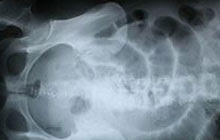A common, chronic condition, often associated with marked anxiety and depression, characterized by obsessions and compulsions. Obsessions/compulsions must cause distress or interfere with the person's social or individual functioning (usually by wasting time), and should not be the result of another psychiatric disorder. At some point in the disorder, the person recognizes the symptoms to be excessive or unreasonable.
Clinical features
Checking (63%), washing (50%), contamination (45%), doubting (42%), bodily fears (36%), counting (36%), insistence on symmetry (31%), aggressive thoughts (28%).
Epidemiology
Mean age: 20 yrs, 70% onset before age 25 yrs, 15% after age 35 yrs. Sex distribution equal. Prevalence: 0.5 2% of general population.
Associations
Avoidant, dependent, histrionic traits (-40% of cases), antistatic / obsessive-compulsive traits (15%) prior to disorder. In schizophrenia, 45% of patients may present with symptoms of OCD schizo-obsessive's poorer prognosis). Sydenham chorea (up to 70% of cases) and other basal ganglia disorders (e.g. TS, post-encephalitic parkinsonism).
Co morbidity
Depressive disorder (70%), alcohol- and drug-related disorders, social phobia, specific phobia, panic disorder, eating disorder, tic disorder (up to 40% in juvenile OCD) or TS.
Read More
Clinical features
Checking (63%), washing (50%), contamination (45%), doubting (42%), bodily fears (36%), counting (36%), insistence on symmetry (31%), aggressive thoughts (28%).
Epidemiology
Mean age: 20 yrs, 70% onset before age 25 yrs, 15% after age 35 yrs. Sex distribution equal. Prevalence: 0.5 2% of general population.
Associations
Avoidant, dependent, histrionic traits (-40% of cases), antistatic / obsessive-compulsive traits (15%) prior to disorder. In schizophrenia, 45% of patients may present with symptoms of OCD schizo-obsessive's poorer prognosis). Sydenham chorea (up to 70% of cases) and other basal ganglia disorders (e.g. TS, post-encephalitic parkinsonism).
Co morbidity
Depressive disorder (70%), alcohol- and drug-related disorders, social phobia, specific phobia, panic disorder, eating disorder, tic disorder (up to 40% in juvenile OCD) or TS.






